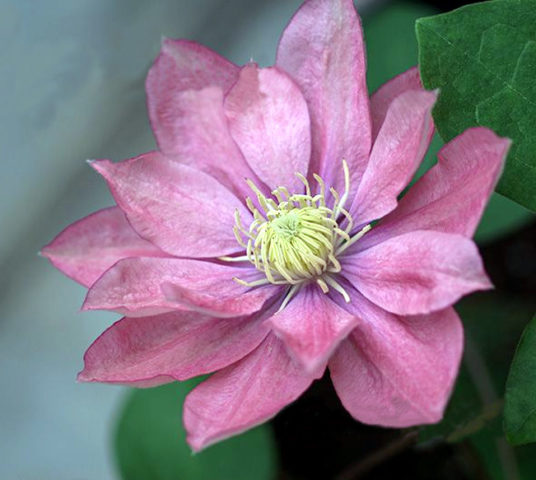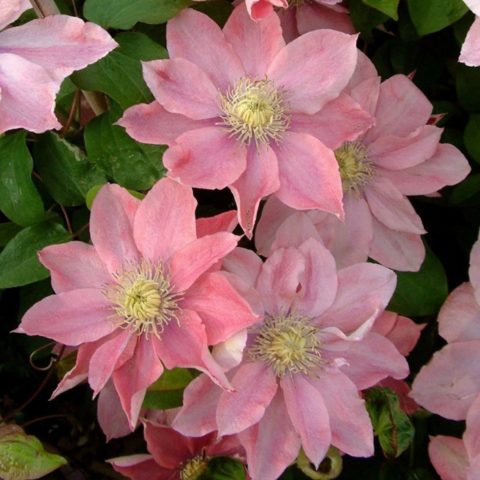Content
Clematis Little Mermaid belongs to the Japanese selection. Takashi Watanabe became the author of the variety in 1994. In translation, the variety is called "little mermaid". Belongs to the class of large-flowered, early-flowering clematis. A light-loving, climbing plant is used for vertical gardening of areas.
Description of Clematis Little Mermaid
Clematis Little Mermaid belongs to the group of vines. Shoots reach a length of up to 2 m. For cultivation, it is necessary to arrange supports along which the plant will climb.
Little Mermaid flowers are pale pink with a salmon tint. Anthers form a bright light yellow center. According to photos and reviews, Clematis Little Mermaid forms large flowers, with a diameter of 8 to 12 cm.The flowering is long and abundant. During the warm season, there are two waves of flowering, the first - from May to June on the shoots of last year, the second - in August-September on the shoots formed this year.
The frost resistance of the variety belongs to 4-9 zones. The root system of the plant is able to withstand frosts down to -35 ° C. But the shoots remaining above the ground, on which flower buds are laid at the end of the current season, must be covered.
Clematis trimming group Little Mermaid
Large-flowered Clematis Little Mermaid belongs to the second pruning group. Shoots are pruned twice per season. The first time last year's stems are cut after the end of flowering. Remove the faded part or, if the shoot is weak, cut it off completely.
Shoots that have appeared in the current year are pruned weakly, leaving 10-15 knots. Sick or weak stems are completely removed. If the shoots of the current year are cut off completely from the Little Mermaid plant, flowering will begin only at the end of summer and will be few.
Planting and caring for Clematis Little Mermaid
Clematis Little Mermaid is planted in a warm, sunny place, in an area without a tendency to waterlogging and the appearance of drafts. For planting, you need a loose soil with good water permeability, neutral acidity.
When planting, Clematis Little Mermaid is buried 5-10 cm below soil level. The soil is gradually poured into the formed funnel during the season. The soil under clematis must be mulched. The root collar is covered with sand. The base of the plant must be shaded. For this, from the side where the sun's rays fall on the soil, annual flowers, for example, marigolds, are planted.
Watering the culture needs regular so that the soil does not dry out. Moisture is necessary to maintain a large leaf mass and thermoregulation of the plant.
In the fall, in the first year of planting, Clematis Little Mermaid is pruned to the first true leaf. In the future, the vines are cut according to the 2nd group.
According to the photo and description of Clematis Little Mermaid, for abundant flowering, he is shown feeding at least 5 times per season.
Top dressing scheme:
- At the end of April, the plant is fed with ammonium nitrate. For an adult bush, fertilizer is dissolved at the rate of 2 g per 10 liters of water or a handful is scattered around the plant. Dry fertilizer is embedded in the soil.
- A week after the first feeding, organic fertilizers are applied in liquid form, for example, an infusion of mullein or grass in a ratio of 1:10. In the absence of organic feeding, a urea solution is used at the rate of 10 g per 10 l of water.
- 2 weeks after the second feeding, a complex fertilizer is used, for example, "Kemiru universal" at the rate of 1 tbsp. l. 10 liters of water.
- During the budding period, phosphorus-potassium fertilizers are used without the inclusion of chlorine.
- After the first abundant flowering and pruning, feeding is carried out using a full complex fertilizer.
When feeding Clematis Little Mermaid, it is important to alternate mineral and organic fertilizers. Do not use top dressing during flowering. At the beginning of the season, the climbing plant is watered with milk of lime, and at the end of the season, several glasses of ash are brought in.
Preparing for winter
Preparation is carried out at the onset of subzero temperatures. The mulch and sand from the root collar are carefully raked off and the base of the bush is sprayed with a solution of ferrous sulfate. Pour in new, pre-disinfected sand. To warm the root collar, peat or well-rotted manure is poured onto it.
The shoots cut and removed from the support are twisted into a ring and pressed to the soil. Spruce branches are applied from below and from above and the structure is covered with non-woven material.
In spring, clematis is opened gradually, the plant starts growing very early at a temperature of + 5 ° C. At this time, shoots must be lifted, examined, weak and damaged, cut off. Overwintered bare shoots have nothing to cling to the support with, so they should be independently distributed and tied to the support. The sand in the root part is replaced with a new one. The soil, as in the autumn, is sprayed with a copper-containing preparation.
Reproduction
For hybrid clematis Little Mermed, a vegetative reproduction method is used. The following methods are used: cuttings, rooting of cuttings and dividing the bush. Cutting and propagation by layering are one of the main ways to get new planting material. The method of dividing the bush is used for plants up to 7 years old, because older clematis do not tolerate a violation of the root system and subsequent transplantation.
Diseases and pests
Clematis Little Mermaid does not have specific diseases, but is often exposed to fungal infections. To prevent the appearance of diseases, clematis are planted in places that can be ventilated, but without strong gusts of wind. Plants for prevention are sprayed with fungicides and preparations containing copper.
One of the most serious pests of clematis is the nematode. Delicate roots and young shoots of the plant damage mice and bears. In dry weather, a spider mite may appear on the plant. Insecticides are used against insecticides and acaricides.
Conclusion
Clematis Little Mermaid is a picturesque, climbing perennial plant. Pergolas and trellises are decorated with clematis, giving them a different shape, and allowed on fences and along walls. Observing the peculiarities of planting, care and shelter, Clematis Little Mermaid will delight for a long time with its delicate abundant flowering.










